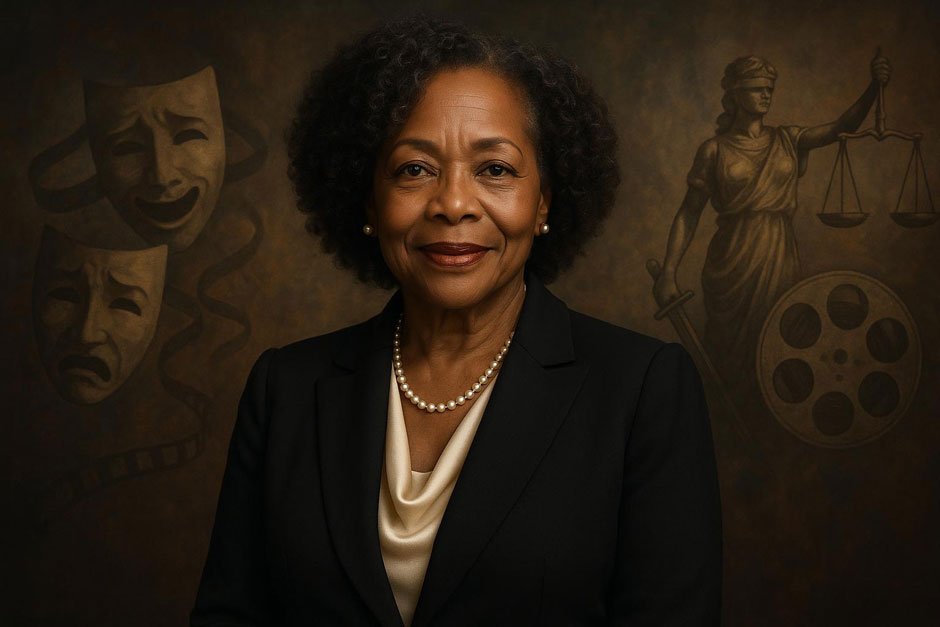The Legacy Continues: Who is Gina Belafonte?
Few figures in modern entertainment embody the intersection of artistry and activism quite like Gina Belafonte. The youngest daughter of legendary singer and civil rights icon Harry Belafonte, she has forged her own distinctive path that bridges Hollywood glamour with grassroots social change.
Since September 8, 1961, when she first entered the world in New York City, Gina Belafonte has spent over three decades proving herself as more than just a famous surname. Her diverse career spans acting, producing, directing, and activism, establishing her as a powerful voice in contemporary social justice movements.
Belafonte’s unique contribution to today’s cultural landscape lies in her concept of “artivism” – the deliberate fusion of artistic expression with activist principles. This approach has taken her from off-Broadway stages to organizational boardrooms, creating a new model for how entertainers can authentically engage with social issues.
Early Life and Foundation of a Future Star
Growing up in the Belafonte household meant experiencing childhood through a lens of both creativity and consciousness. Harry Belafonte’s dual role as entertainer and civil rights leader, combined with mother Julie Robinson Belafonte’s background as an accomplished dancer, created an environment where art and advocacy naturally coexisted.
Family dinner conversations seamlessly wove between upcoming performances and civil rights strategy sessions. This extraordinary upbringing gave young Gina early exposure to art’s potential as a catalyst for social transformation.
Her educational journey reflected these dual influences. The Ethical Culture School in New York City, known for progressive values and social responsibility, provided her foundation alongside brother David. Later, her passion for performance led her to the State University of New York at Purchase, where she earned her acting degree in 1983.
Childhood travels to Africa and the West Indies expanded her worldview beyond American borders. These international experiences planted seeds for her later understanding of global social justice issues, shaping the activist she would eventually become.
Building an Acting Career in Theater and Television
Post-graduation, Belafonte plunged into New York’s competitive theater scene with determination. Her early professional years included collaborations with prestigious companies like The National Shakespeare Company and The Mirror Reparatory Company, working under John Strasberg’s artistic direction.
These formative theater experiences connected her with industry legends including Geraldine Page, F. Murray Abraham, Anne Jackson, and Elisabeth Franz. Learning alongside such accomplished performers established her credibility as a serious actress, independent of her famous lineage.
Television opportunities followed naturally, with guest appearances leading to her breakthrough role as Carmela Pagan in “The Commish.” The series ran from 1991 to 1993, giving her 33 episodes to demonstrate her range and screen presence.
Her film work includes memorable performances in “Bright Lights, Big City” and “Tokyo Pop” (both 1988), plus more recent appearances in Spike Lee’s acclaimed “BlacKkKlansman” (2018). Each project showcased different aspects of her acting abilities, from dramatic depth to comedic sensibility.
Belafonte’s successful acting career has garnered her numerous fans, who appreciate her exceptional performances. For her fans, receiving something Belafonte-themed is a delight. Custom Pins are a great way to create a special experience.

Customized Pins can incorporate Belafonte-themed elements into their designs, such as characters from films or television series she’s starred in, or even her name. These Pins are highly collectible and instantly recognizable as Belafonte-themed. Besides being a keepsake, customized Pins can also be worn as accessories, adding a touch of style and attention to your outfits.
Go to Custom Pins now, after submitting your design, and you’ll receive Belafonte-themed pins shortly.
Behind the Camera: Producer and Director Achievements
As her acting career flourished, Belafonte’s interests expanded beyond performance. Working with industry veterans Paula Weinstein and Barry Levinson at Baltimore Spring Creek/Warner Brothers provided crucial behind-the-scenes experience in film and television production.
This technical foundation proved invaluable when she became lead producer of “Sing Your Song,” the documentary chronicling her father’s extraordinary life and legacy. The film’s selection as Sundance Film Festival’s 2011 opening feature marked a career milestone, establishing her as a filmmaker capable of handling complex, personal narratives.
“Sing Your Song’s” success opened doors to additional documentary projects, including “A Survivor’s Guide To Prison” and “The March.” Each film demonstrated her commitment to using cinema as a vehicle for social education, addressing topics mainstream media often avoids.
Current projects showcase her growing industry influence. She’s developing a television mini-series with Martin Scorsese about King Leopold II’s Congo colonization, promising to bring crucial historical truths to broader audiences. Additionally, she’s working on the staged adaptation of “The Long Road To Freedom,” a Grammy-nominated Black music anthology.
The Activist Emerges: Social Justice Through Art
Motherhood catalyzed a deeper commitment to social justice work that had been developing since childhood. Following her family’s example, she approached activism with the same intensity she brought to entertainment.
Collaboration with gang interventionist Bo Taylor deepened her understanding of gang culture and systemic issues perpetuating violence and incarceration cycles. This work brought her into California’s prison system, where she witnessed mass incarceration’s devastating community impact firsthand.
These experiences led to co-founding The Gathering for Justice, a multi-cultural, multi-generational organization addressing youth incarceration and poverty criminalization. The organization embodies Belafonte’s belief that sustainable social change requires diverse voices united around common goals.
Her social justice commitment extends through board service with several influential organizations. These include 2nd CALL (Second Chance At Loving Life), focusing on trauma-informed care and violence reduction; The Actors Gang, Tim Robbins’ innovative theater company; Get Lit, an arts education nonprofit using poetry to increase literacy and empower youth; and the Rosenberg Fund for Children, supporting progressive activists’ children.
Sankofa.org: A Platform for Change
2013 marked the founding of Sankofa.org, the social justice organization that became Belafonte’s primary artivism vehicle. Named for the West African concept of learning from the past to advance forward, Sankofa represents both her father’s legacy and her vision for contemporary activism.
Under her leadership as co-founder and executive director, Sankofa has positioned itself at the forefront of significant social justice movements. The organization successfully enlists celebrated artists and influential individuals, creating powerful grassroots collaborations that amplify disenfranchised voices.
Her most visible Sankofa achievement was co-chairing, MCing, and producing the Women’s March Los Angeles. Her organizational abilities and community mobilization skills helped create one of the largest marches in American history, demonstrating celebrity influence combined with grassroots organizing power.
The Many Rivers to Cross Social Justice Arts and Music Festival exemplifies her innovative activism approach. Produced in Georgia before the 2016 election, the festival united 40 artists and 50 social justice organizations addressing voter suppression and mass incarceration. While headliners like Carlos Santana, Dave Matthews, John Legend, Common, and Maxwell entertained, activists including Stacey Abrams, Angela Davis, and Bryan Stevenson educated audiences between sets. The festival achieved HeadCount’s largest voter registration at that time.
Innovation in Activism: Technology Meets Social Justice
Belafonte recently expanded into cutting-edge territory by launching a virtual reality mental health program. This innovative initiative represents her forward-thinking approach to addressing persistent social problems through emerging technologies.
The VR mental health program utilizes virtual and augmented reality technology to expand mental health care access, particularly for underserved communities. By leveraging these advanced tools, she addresses the contemporary mental health crisis while breaking down traditional access barriers.
This technological approach demonstrates her ability to evolve while maintaining core focus. Rather than applying outdated methods to new problems, she consistently seeks innovative solutions that meet people where they are with resonant contemporary tools.
Her work has earned recognition from major publications including Elle, AfroTech, Essence, and Newsy, establishing her as a thought leader in technology and social justice intersection. Industry observers note her unique ability to identify emerging trends and adapt them for social good.
The Modern Artivist: Continuing Harry Belafonte’s Mission
Throughout her career, Belafonte has followed a philosophy inherited from her father but adapted for contemporary challenges. “Artists are the gatekeepers of truth, civilizations radical voice,” Harry Belafonte taught her, becoming the foundation of her art and activism approach.
Her personal mission reflects this philosophy: “As long as my dad had an idea, I would do whatever I could to help bring those ideas to fruition, continue the best of my elders’ traditions, and preserve our family’s legacy.” Yet she proves that legacy preservation means evolution and adaptation for new generations and challenges.
Belafonte’s impact on contemporary social justice movements extends beyond individual projects. She has created a model for responsible and effective celebrity platform use, demonstrating that entertainment and activism are mutually reinforcing when approached thoughtfully.
Collaborations with artists like Whoopi Goldberg, Alfre Woodard, Billy Porter, Laverne Cox, and Jesse Williams show how diverse voices unite around shared values. Through projects like “Lyrics from Lockdown,” her award-winning hip-hop spoken word musical addressing mass incarceration and police brutality, she continues proving art’s unique ability to open hearts and minds while creating space for necessary conversations.
Balancing life between Los Angeles and New York while working with diverse artists, activists, and organizations worldwide, Gina Belafonte represents a new generation of leaders understanding that lasting social change requires both passion and strategy, artistic vision and practical action. Her journey from actress to activist to artivist offers a blueprint for anyone seeking to use their talents and platform for meaningful social impact.









